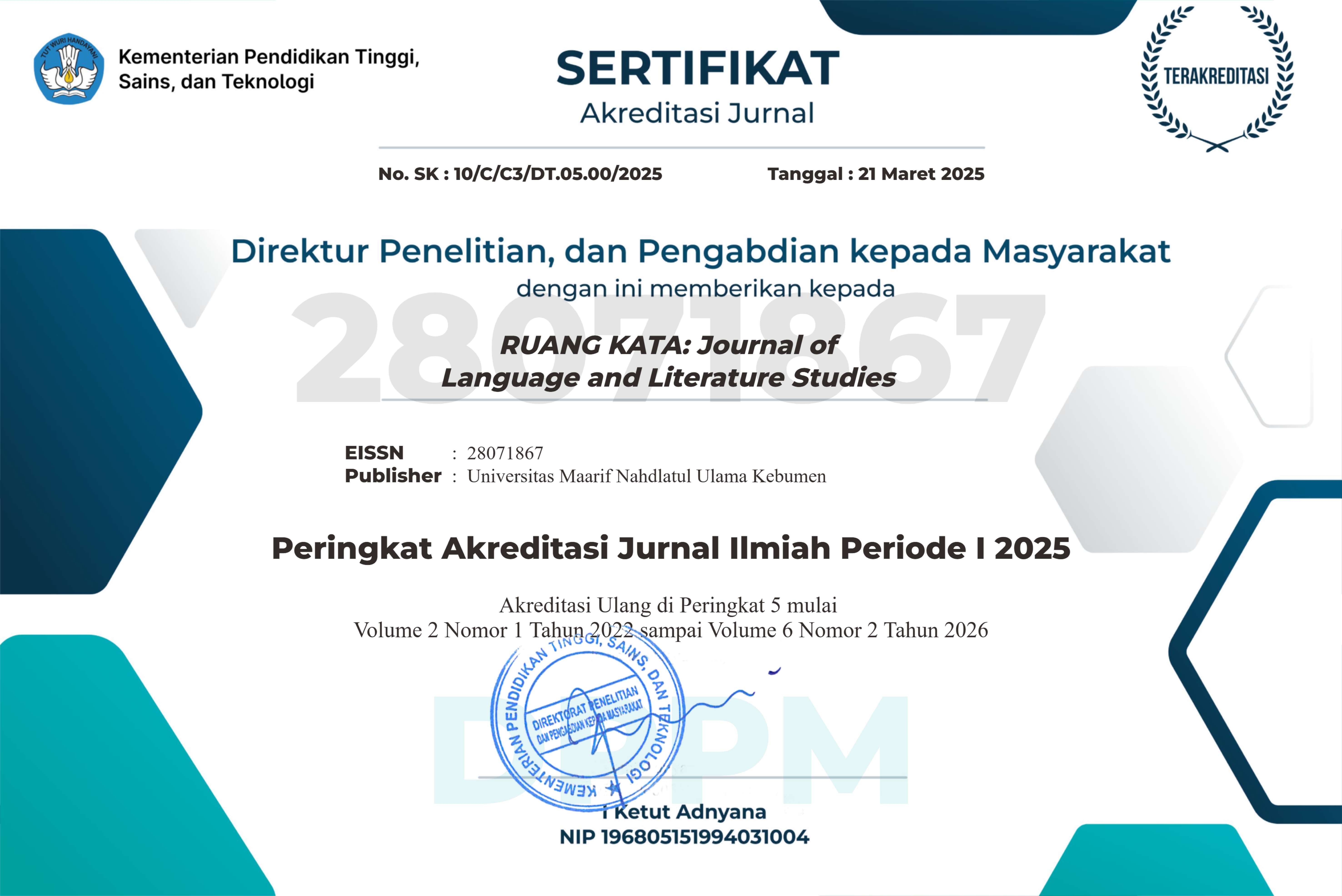The Analysis of Fillers on Live Youtube Video Grammar Lesson
DOI:
https://doi.org/10.53863/jrk.v5i02.1649Keywords:
english language, fillers, pause, speaking process, youtubeAbstract
Fillers are words, phrases, or even sounds which are utilized to fill the silence phase of the speaking process that always be viewed as a lack of speaking skills or disfluency. There are two types of fillers based on Rose (1998) which are unlexicalized fillers and lexicalized fillers. However, there are 5 functions of fillers based on Stenstrom (1994) namely, hesitating, empathizing, mitigating, editing terms, and time-creating devices. Furthermore, this study intends to uncover the types of fillers and the functions of fillers utilized by Aga Murdoch as an English native speaker in her live YouTube video. In this live YouTube video, she teaches about English grammar especially tenses. Therefore, the utterances that utilized in this teaching is a source of data that will be studied. Content analysis and qualitative approach are used as the methodology of this study. However, this study also uses data reduction, data presentation and drawing conclusion to manage the data. In order to ensure the validity and trustworthiness of the results, this study will also utilize investigator triangulation. On the other hand, the outcome of this study showed that Aga Murdoch used 147 fillers. In this study, there were 67 unlexicalized fillers dan 80 lexicalized fillers. As a conclusion, fillers have a prominent role to maintain a good speaking process. Besides, several aspects should be fulfilled when using fillers in daily interactions. Moreover, this study is expected to enhance speaking skill awareness and provide more comprehension regarding filler
References
Adini, D. S., Riza, A., & Afriyanti, R. (2021). Pause Filler Used by Students in Microteaching Class. Ekasakti Educational Journal, 1(1), 83-90.
Al-Faragy, R. F. H., Al Khalifawi, S. H. S., & Alqaisi, H. H. H. (2025). An Analysis of Speech Fillers Used by Biden. Journal of Language Studies, 9(1), 346-360.
Ali, M. M., Malik, A. G., & Sayyed, S. S. H. (2023). Exploring the Use of Fillers in English Language Classrooms. Balochistan Journal of Linguistics, 11, 21-21
Arrasul, A. R., Mangendre, Y., TA, F. A., & Hardianti, S. (2024). Learners’ Fillers in English. Applied Research on English Education (AREE), 2(1), 20-31.
Beňuš, Š. (2021). Investigating Spoken English: A Practical Guide to Phonetics and Phonology Using Praat. Springer International Publishing.
Biber, D., Johansson, S., Leech, G. N., Conrad, S., & Finegan, E. (2021). Grammar of Spoken and Written English. John Benjamins Publishing Company.
Cahyo, D. W., Fatsah, H., & Tanipu, Z. (2025). The Use of Fillers in Spoken Discourse Video by Students at English Language Education Study Program of State University of Gorontalo. Research Review: Jurnal Ilmiah Multidisiplin, 4(1), 38-46.
Dinkar, T., Vasilescu, I., Pelachaud, C., & Clavel, C. (2020). How Confident Are You? Exploring the Role of Fillers in the Automatic Prediction of a Speaker’s Confidence. International Conference on Acoustics, Speech and Signal Processing, 8104-8108. https://doi.org/10.1109/ICASSP40776.2020.9054374
Drisko, J. W., & Maschi, T. (2016). Content Analysis. Pocket Guides to Social Work Research Methods. In Oxford University.
Edy, S. (2023). Communication Strategies Used by Indonesian Teacher toward Thai Students in Teaching English at Chariyhatam Suksa Foundation School. ELITE JOURNAL, 5(1), 53-58.
Edwards, V. V. (2022). Cues: Master the Secret Language of Charismatic Communication. Penguin Publishing Group.
English with Aga. (2025, Aprill 1). English Tenses: Live English Grammar Lesson. [Video]. YouTube. https://www.youtube.com/watch?v=0gSPlhUrNHc&list=PLX0lDsmggKlu1ROOjLJBwMcNmtqgWPrqx&index=9
Faulkner, M. (2015). A Novice's Guide to Speaking in Public: 10 Steps to Help You Succeed in Your Next Presentation... Without Years of Training!. Pearson Education.
Firiady, M., & Mahendra, A. W. (2019). A Study of Fillers Uttered in English Public Speaking. ELTR Journal, 3(2), 136-148. https://doi.org/10.37147/eltr.v3i2.98
Fitriati, S. W., Mujiyanto, J., Susilowati, E., & Akmilia, P. M. (2021). The Use of Conversation Fillers in English by Indonesian EFL Master’s Students. Linguistic Research, 38. https://doi.org/10.17250/khisli.38..202109.002
Hermawan, S. (2022). Speech Disfluency in Ellen Degeneres Talk Show: A Psycholinguistics Study. AMCA Journal of Education and Behavioral Change, 2(1), 32-38. https://doi.org/10.51773/ajeb.v2i1.142
Houghton, Z., Kato, M., Baese-Berk, M., & Vaughn, C. (2023). Task-Dependent Consequences of Disfluency in Perception of Native and Non-Native Speech. Applied Psycholinguistics, 45(1), 64-80. https://doi.org/10.1017/S0142716423000486
Indriyana, B. S., Sina, M. W., & Bram, B. (2021). Fillers and Their Functions in Emma Watson’s Speech. Ranah: Jurnal Kajian Bahasa, 10(1), 13-21.
Jazadi, I. (2023). An Analysis of Time Orientation in Informal Conversation of Tatede Villeges in Sumbawa Regency. GLOBAL: Education Language and Humanity Journal, 1(1), 19-28.
Juliano, F., Nehe, I., & Handayani, N. D. (2022). An Analysis of Fillers Used by Bill Gates in the David Rubenstein Show. Proceeding of Undergraduate Conference on Literature, Linguistic, and Cultural Studies, 1. https://doi.org/10.30996/uncollcs.v1i.1225
Kennison, S. M. (2018). Psychology of Language: Theory and Applications. Bloomsbury Publishing.
Krippendorff, K. (2018). Content Analysis An Introduction to Its Methodology (4th ed.). Sage Publications.
Kwon, Y. E. (2020). Pragmatic discourse markers you know and sort of in Korean EFL Teacher Corpus. Studies in Foreign Language Education, 34(1), 291-322.
Lăpădat, L. C., Păunescu, A. F., & Lăpădat, M. M. (2024). Focusing on Fluency: Boosting Speaking Skills in Foreign Language Acquisition. Revista de Stiinte Politice, (84), 202-209.
Lomotey, C. F. (2021). Fillers In Academic Discourse: An Analysis of Lectures from a Public University in Ghana. European Journal of Applied Linguistics Studies. https://doi.org/10.46827/ejals.v3i2.248
Maruthy, S. (2023). Introduction to Fluency and Its Development. In S. Maruthy & P. Kelkar (Eds.), Understanding and managing fluency disorders: from theory to practice. (pp. 1–14). Taylor & Francis.
Muchsani, M. (2023). Examining the Use of Fillers in a Presidential Debate: A Case of Hilary Clinton and Donald Trump. Jambura Journal of English Teaching and Literature, 4(1), 42-52
Muthmainna, A., & Siroj, R. A. (2025). Mastering The Art of Qualitative Data Analysis and Interpretation: Key Steps and Procedures. FiHeSu International Journal of Education and Development Research (FIJEES), 2(1).
Muzari, T., Nevers Shava, G., & Shonhiwa, S. (2022). Qualitative Research Paradigm, a Key Research Design for Educational Researchers, Processes and Procedures: A Theoretical Overview. Indiana Journal of Humanities and Social Sciences, 2(1).
Poedjiastutie, D. (2021). A Closer Look of Qualitative Research (A handbook guide for novice researcher)). UMMPres
Remland, M. S. (2017). Nonverbal Communication in Everyday Life. Sage Publications, Inc. https://doi.org/10.4135/9781483399447
Rose, R. L. (1998). The Communicative Value of Filled Pauses in Spontaneous Speech. MA Diss., Univ. of Birmingham.
Qizi, D. A. A. (2023). The Role of Grammar in Learning English Language. American Journal of Social Sciences And Humanity Research, 03(05). https://doi.org/10.37547/ajsshr/volume03issue05-21
Sarira, P., Mahmud, M., Affandi, A., & Burhamzah, M. (2023). The Existence of Fillers in Converting the Written Language to Spoken Language. Borneo Journal of English Language Education, 5(1).
Setiawan, R., & Novita, D. (2024). Youtube Implementation in Teaching English as a Foreign Language: A review. Pubmedia Journal Pendidikan Bahasa Inggris, 1(4), 12.
Shokirova, C. (2025). The Importance of Grammar in Learning a Foreign Language. In Conference Proceedings: Fostering Your Research Spirit (pp. 73-74).
Shoufan, A., & Mohamed, F. (2022). YouTube and Education: A Scoping Review. In IEEE Access (Vol. 10). https://doi.org/10.1109/ACCESS.2022.3225419
Stenstrom, A. B. (1994). An introduction to spoken interaction. London: Longman.
Wagner, E., & Toth, P. D. (2017). The Role of Pronunciation in the Assessment of Second Language Listening Ability. In T. Isaacs & P. Trofimovich (Eds.), Second Language Pronunciation Assessment: Interdisciplinary Perspectives (Vol. 107, pp. 72–92). Multilingual Matters / Channel View Publications.
Zarzycki, Ł. (2021). The Implementation of YouTube Resources in Language Learning. In CALL for Background.
Downloads
Published
How to Cite
License
Copyright (c) 2025 Sekar Lathifatul Aliyah, Farikah Farikah, Rolisda Yosintha

This work is licensed under a Creative Commons Attribution-ShareAlike 4.0 International License.
Authors retain copyright and grant the journal right of first publication with the work simultaneously licensed under a Creative Commons Attribution-ShareAlike 4.0 International License that allows others to share the work with an acknowledgment of the work’s authorship and initial publication in this journal














